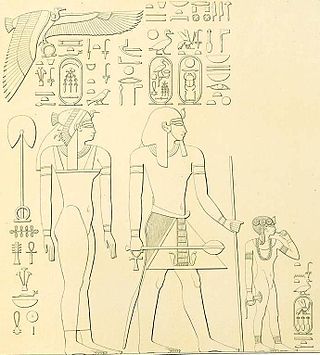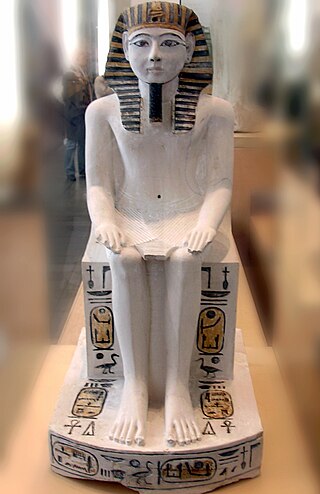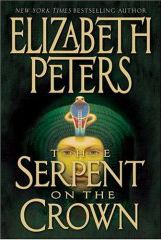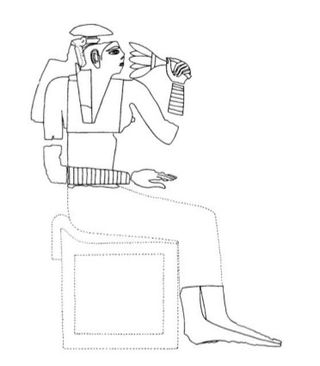
Hatshepsut was the Great Royal Wife of Pharaoh Thutmose II and the fifth Pharaoh of the Eighteenth Dynasty of Egypt, ruling first as regent, then as queen regnant from c. 1479 BC until c. 1458 BC. She was Egypt's second confirmed queen regnant, the first being Sobekneferu/Nefrusobek in the Twelfth Dynasty.
Thutmose, also known as "The King's Favourite and Master of Works, the Sculptor Thutmose", was an Ancient Egyptian sculptor in the Amarna style. He flourished around 1350 BC, and is thought to have been the official court sculptor of the Egyptian pharaoh Akhenaten in the latter part of his reign. A German archaeological expedition digging in Akhenaten's deserted city of Akhetaten, known today as Amarna, found a ruined house and studio complex in early December 1912; the building was identified as that of Thutmose based on an ivory horse blinker found in a rubbish pit in the courtyard inscribed with his name and job title. Since it gave his occupation as "sculptor" and the building was clearly a sculpture workshop, the determination seemed logical and has proven to be accurate.

Horemheb, also spelled Horemhab or Haremhab, was the last pharaoh of the 18th Dynasty of Egypt. He ruled for at least 14 years between 1319 BC and 1292 BC. He had no relation to the preceding royal family other than by marriage to Mutnedjmet, who is thought to have been the daughter of his predecessor, Ay; he is believed to have been of common birth.

Ahmose was an Ancient Egyptian queen in the Eighteenth Dynasty. She was the Great Royal Wife of the dynasty's third pharaoh, Thutmose I, and the mother of the queen and pharaoh Hatshepsut. Her name means "Born of the Moon".

Thutmose I was the third pharaoh of the 18th Dynasty of Egypt. He received the throne after the death of the previous king, Amenhotep I. During his reign, he campaigned deep into the Levant and Nubia, pushing the borders of Egypt farther than ever before in each region. He also built many temples in Egypt, and a tomb for himself in the Valley of the Kings; he is the first king confirmed to have done this.

Thutmose II was the fourth Pharaoh of the Eighteenth Dynasty of Egypt, and his reign is generally dated from 1493 to 1479 BC. Little is known about him and he is overshadowed by his father Thutmose I, half-sister and wife Hatshepsut, and son Thutmose III. He died around the age of 30 and his body was found in the Deir el-Bahri Cache above the Mortuary Temple of Hatshepsut.

Amenhotep I or Amenophis I, was the second Pharaoh of the 18th Dynasty of Egypt. His reign is generally dated from 1526 to 1506 BC.

Thutmose IV was the 8th Pharaoh of the 18th Dynasty of Egypt, who ruled in approximately the 14th century BC. His prenomen or royal name, Menkheperure, means "Established in forms is Re." He was the son of Amenhotep II and Tiaa.

The New Kingdom, also referred to as the Egyptian Empire, was the ancient Egyptian nation between the 16th century BC and the 11th century BC. This period of ancient Egyptian history covers the Eighteenth, Nineteenth, and Twentieth Dynasties. Through radiocarbon dating, the establishment of the New Kingdom has been placed between 1570 BC and 1544 BC. The New Kingdom followed the Second Intermediate Period and was succeeded by the Third Intermediate Period. It was the most prosperous time for the Egyptian people and marked the peak of Egypt's power.

Tomb KV42 is an ancient Egyptian tomb in the Valley of the Kings near Luxor, Egypt. It was constructed for Hatshepsut-Meryetre, the wife of Thutmose III, but she was not buried in the tomb. It may have been reused by Sennefer, a mayor of Thebes during the reign of Amenhotep II, and by several members of his family. The tomb has a cartouche-shaped burial chamber, like other early Eighteenth Dynasty tombs.

Tomb KV36 is the burial place of the noble Maiherpri of the Eighteenth Dynasty in the Valley of the Kings, Egypt.

The Valley of the Kings, also known as the Valley of the Gates of the Kings, is an area in Egypt where, for a period of nearly 500 years from the Eighteenth Dynasty to the Twentieth Dynasty, rock-cut tombs were excavated for pharaohs and powerful nobles under the New Kingdom of ancient Egypt.

Ahmose-Meritamun was a Queen of Egypt during the early Eighteenth Dynasty. She was both the older sister and the wife of Pharaoh Amenhotep I. She died fairly young and was buried in tomb TT358 in Deir el-Bahari.

The Serpent on the Crown is the 17th in a series of historical mystery novels, written by Elizabeth Peters and published in 2005. It features fictional sleuth and archaeologist Amelia Peabody. The story is set in 1922, in the dig season in Egypt.

Hetepheres I was a queen of Egypt during the Fourth Dynasty of Egypt who was a wife of one king, the mother of the next king, the grandmother of two more kings, and the figure who tied together two dynasties.

Satiah was an ancient Egyptian queen, the first Great Royal Wife of Pharaoh Thutmose III.
Sesheshet, occasionally known as Sesh, was the mother of King Teti, the first and founding pharaoh of the Sixth Dynasty of Ancient Egypt. She was instrumental in enabling her son to gain the throne and reconciling two warring factions of the royal family.

Djehuty was a general under the ancient Egyptian king Thutmose III in the 18th Dynasty. He is known as the main hero of the tale of "The Taking of Joppa". Djehuty bears the titles king's scribe, overseer of troops (general) and overseer of the northern foreign countries in contemporary Egyptian records.

The Eighteenth Dynasty of Egypt is classified as the first dynasty of the New Kingdom of Egypt, the era in which ancient Egypt achieved the peak of its power. The Eighteenth Dynasty spanned the period from 1550/1549 to 1292 BC. This dynasty is also known as the Thutmosid Dynasty for the four pharaohs named Thutmose.

Egyptian finger and toe stalls are pieces of gold jewelry used in Ancient Egypt to protect digits during burial. Such stalls were used during the 18th Dynasty of Egypt, as well as other eras, and were thought to protect the deceased from both magical and physical dangers, such as damage which could occur during the mummification process. Additionally, they were sometimes used in order to replace missing digits on the deceased, as it was believed that a complete body was needed for successful passage into the afterlife. This belief mirrors the myth of Osiris, whose body was put back together by his wife Isis, resulting in him becoming the first mummy. Some mummies were buried with prosthetics which they used in life, rather than toe stalls created specifically for burial. These stalls were most commonly found on the remains of royalty. Toe stalls were discovered in the tomb of Tutankhamun, and a nearly complete set of finger and toe stalls was discovered in the tomb of three of the wives of Thutmose III in Thebes. The wives' jewelry is currently on display at the Metropolitan Museum of Art. The stalls from this tomb are some of the earliest known, originating from the early 18th Dynasty. A later surviving example of toe stalls comes from the tomb of Psusennes I, a 21st Dynasty ruler. Although many surviving examples of finger and toe stalls originate from the 18th Dynasty, they were used for much of Ancient Egypt, including into the Ptolemaic and Roman periods. For example, one mummy from this period was found with carved golden finger stalls, similar to those discovered from earlier periods. Though royalty and the upper classes typically had stalls made of gold or silver, less wealthy Egyptians utilized other materials, including wood, stone, and/or mud. In order to provide magical protection for the deceased, a prayer was made to Osiris as the stalls were created. The stalls were often highly detailed, with carved nails and other features, such as rings.

















